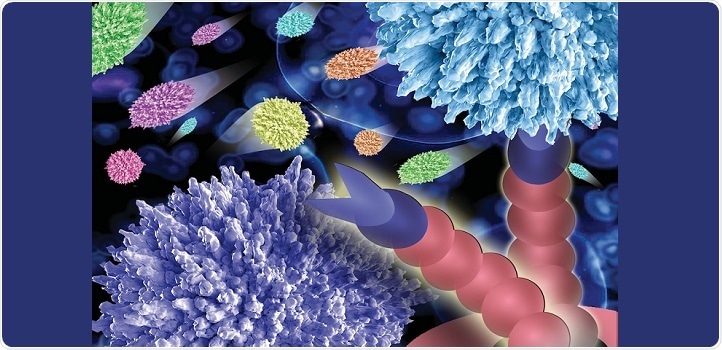Fluorescent tagging is a powerful and efficient way of analyzing the communications between cells. This method enables the concurrent analysis of numerous cell populations, accelerating a once limiting and tedious procedure.

The new assay developed at KAUST is a fluorescent multiplex cell rolling assay that uses unique fluorescent tags to label up to seven cell population types. Image Credit: © 2020 Elham Roshdy.
King Abdullah University of Science and Technology (KAUST) has now developed a novel assay that can also be used for analyzing the cellular processes in cancer cell metastasis or inflammation, and for evaluating promising treatments.
Cells travel through blood vessels by means of cell adhesion—the attachment and interaction of cells to each other through specialized molecules on the surfaces of the cells. At the time of blood flow, shear forces generally act on the cells to help orchestrate the adhesion of cells.
The exploitation of cell adhesion can result in inflammation and diseases, such as cancer, whereas microbes like viruses manipulate the adhesion of cells to infect the body.
The conventional assay used to study cell-cell interactions is the parallel plate flow chamber (PPFC) assay, which records videos of cells rolling in flow and adhering to molecules on endothelial cells (blood vessel lining cells). This assay has been used for decades, but it is prone to error and possible bias, and it can only analyze one cell type at a time, making it hugely time consuming.”
Jasmeen Merzaban, Group Leader, King Abdullah University of Science and Technology
Ayman AbuElela, along with other graduate students in Merzaban’s laboratory, wished to enhance upon PPFC and expedite the analyses.
The new fluorescent multiplex cell rolling assay (FMCR) developed by the researchers employs special fluorescent tags to mark up to seven cell population types. These cell samples are combined just before they enter the simulated flow across an endothelial cell layer.
A spectral confocal microscope records images of the combined cell populations at high temporal resolution and in real-time in a single pass. This enables the scientists to gather data on cell kinetics, such as the velocity, rolling frequency, and tethering capability of each cell type.
We developed a comprehensive data analysis pipeline, which enables us to analyze the multiple cell types we obtain by this approach and achieves high statistical power and sensitivity. FMCR is now used in our lab to study the migration of various human cells including stem cells activated immune cells and breast cancer cells.”
Ayman AbuElela, King Abdullah University of Science and Technology
Yet another benefit of the latest process is that during or before the assay, a test compound, for instance, a novel drug, can be added to the cells to study how the compound influences the adhesion of cells.
Such studies provide major insights into the effect of treatments on the migration and metastasis of cells and on how the drugs might work inside the body.”
Jasmeen Merzaban, Group Leader, King Abdullah University of Science and Technology
Source:
Journal reference:
AbuElela, A. F., et al. (2020) Fluorescent Multiplex Cell Rolling Assay: Simultaneous Capturing up to Seven Samples in Real-Time Using Spectral Confocal Microscopy. Analytical Chemistry. doi.org/10.1021/acs.analchem.9b04549.